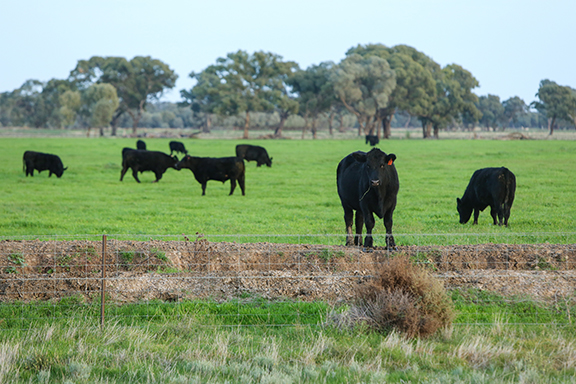When cattle get too much of a good thing
03 Aug 2021
 PRODUCTION ADVICE - AUGUST 2021 - ANIMAL WELFARE
PRODUCTION ADVICE - AUGUST 2021 - ANIMAL WELFARE
By Adrian Smith
Senior Land Services Officer - Mixed Farming Systems
P: 03 5881 9932 | M: 0447 778 515 | E: adrian.smith@lls.nsw.gov.au
 Many producers will be aware of the problems of acute acidosis in their cattle. Such cases are the result of lactic acid build-up within the animal and a rapid lowering of rumen pH. Often death is the result.
Many producers will be aware of the problems of acute acidosis in their cattle. Such cases are the result of lactic acid build-up within the animal and a rapid lowering of rumen pH. Often death is the result.
We typically associate this acute acidosis with cattle consuming high-grain diets.
However, there is a less-recognised form of ruminal acidosis that may be impacting your herd, which is costing them (and you) lost production and performance.
Sub-acute ruminal acidosis (or SARA) is similar to the more acute (and fatal) form. It is essentially the result of an accumulation (an imbalance) of volatile fatty acids in the rumen, as the animal cannot absorb all the nutrients it is receiving from its diet.
The optimal pH range for the rumen is 5.8-6.1.
Typically, what we see in this SARA condition are rumen pH levels in the range 4.9-5.5. This may not seem like a huge difference, but we must remember that pH is based on a logarithmic scale – a pH of 5, for example, is 10 times more acidic than a pH of 6, and 100 times more acidic than a pH of 7.
Small changes to rumen pH can have large influences on the health of the rumen, and more importantly, the type and make-up of the billions of micro-organisms it contains.
What are the signs of SARA in cattle?
The typical signs of SARA are two-fold.
Firstly, we see faeces which are ‘loose’ and quite watery, and often we will see gas bubbles in the manure.
Secondly, we see animals often lying around seemingly quite content – but without cud chewing.
Apart from these visible signs, the animals appear to be functioning and behaving quite normally.
Within the animal itself, the clinical signs include a lack of gut movement and a distinct decline in saliva production. Saliva production is particularly important, as saliva acts as a buffering agent to counteract the acid produced in the rumen and maintain the pH in its healthy range. Because of this, we often see SARA manifest itself in hot weather as well, as animals typically produce less saliva under such conditions.
What are the consequences of SARA?
SARA is typically a chronic condition, which, if managed correctly, animals can quite readily recover from.
Remember, this condition is sub-acute, so death is unlikely. However, if the condition worsens and moves into the acute form, then deaths can occur.
Because the condition is a consequence of sub-optimal rumen function, we typically see:
- a decrease in the efficiency of digesting both organic matter and fibre
- a decrease in feed conversion efficiency
- a decrease in milk yield and milk solids – a ‘double whammy’ for dairy producers
- a decline in reproductive efficiency.
While it can be difficult to put a precise value on the impacts on performance, producers would expect to see a noticeable decrease in the milk quality and quantity of their dairy cows.
In beef cattle it is more difficult, but if growth rates fell by 15-20 per cent (which could easily be expected) and you were expecting growth rates of 1.5kg/hd/day, then based on current prices of say $6.00/kg/liveweight, the condition could be costing producers as much as (or more than) $2/hd/day in lost production.
What can we do to minimise the effects of SARA?
SARA is often the result of ‘too much of a good thing’. We typically see the condition when there is a change in diet, where the animals are grazing high-quality pastures and forage crops or where there is some inconsistency in the diet.
High-quality pastures often contain higher amounts of nitrogen (protein). More nitrogen entering the rumen can also contribute to a decline in pH and the total quantity of rumen bacteria, which can further exacerbate the condition.
There are some management actions we can take to help minimise the occurrence of SARA in our herds.
1. Provide effective fibre in the diet. This effective fibre is important, as it stimulates cud chewing and the production of saliva (remember saliva acts to buffer the acidity produced in the rumen). Fibre is typically provided in the form of hay – and by effective, the length of the fibre should be at least as wide as the muzzle of the animal. Finely chopped hay or chaff will not provide the benefits.
Importantly, studies have shown that this fibre will stimulate the animal to eat and drink more, which can lead to increased productivity.
One other point to note is that the fibre (hay) you provide must be a good enough quality that the animals will voluntarily consume enough of it. You simple cannot throw out a bit of straw from last years harvest (which might be contaminated with mice excrement this year!) and expect your animals to happily consume it. Simply putting some poor-quality roughage out in the paddock will not provide the benefits to your livestock that they need.
2. Providing a consistent, balanced diet. While this can be challenging at times, it is vital, as changing feeds will lead to changes in the composition of the microorganisms in the rumen. Rapid changes can lead to the death of certain species or proliferation of others. Remember, the rumen is essentially a large fermentation ‘vat’- keeping the balance right is critical in maintaining a healthy gut (and animal).
3. Implement good grazing management. The high-quality, high -protein part of any plant is typically in the youngest leaves. By encouraging (through grazing management) the animal to eat more of the whole plant (leaf and stem), and by consuming slightly older plants, the overall dry matter digestibility and protein of the diet will be moderately reduced, thereby avoiding some of the problems associated with SARA.
There is also some thought that providing a range of species (as opposed to a monoculture) in the pastures (and therefore the diet), will likely have some impacts in reducing the occurrence of the condition. A range of plant maturity, growth and quality in the pasture will certainly help.
4. Provide a buffer in a loose lick. While there may be some benefits in providing a loose lick such as bi-carb, this could be best described as ‘hit or miss’ at best.
We know that not every animal will consume a loose lick in the paddock, nor consume enough. Remember, the rumen can hold over 200 litres of fluid, and for an animal to consume enough buffer to counteract the acid produced above what is optimal would be significant – not to mention costly.
Conclusion
Sub-acute ruminal acidosis is a condition that can affect all ruminant animals. Often the result of changes to, or the consumption of, high-quality diets, it can lead to significant lost production in both beef and dairy cattle.
Careful management, and perhaps most importantly, the provision of effective fibre in the diet will help to alleviate the condition, and lead to improved performance of your livestock.
Talk with your animal health advisors, private veterinarian or district veterinarians at Murray Local land Services to obtain correct diagnosis of the problem, and to seek advice on how to best manage the condition.
This article was in part based on a presentation provided by Owen Rees (Total Result Ag Consulting) for Meat and Livestock Australia, and his contribution is dutifully and gratefully acknowledged.